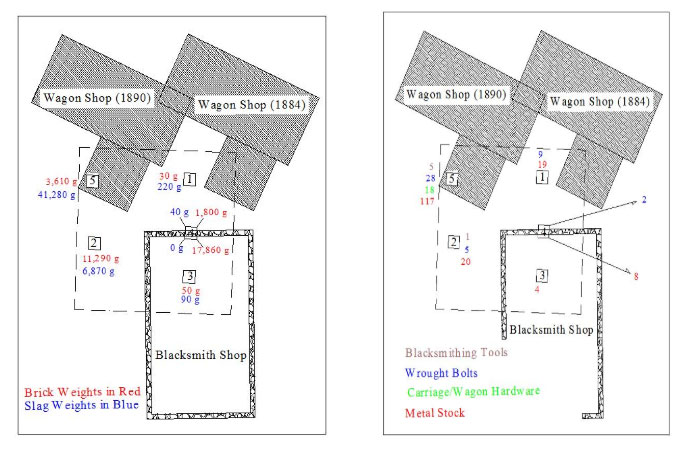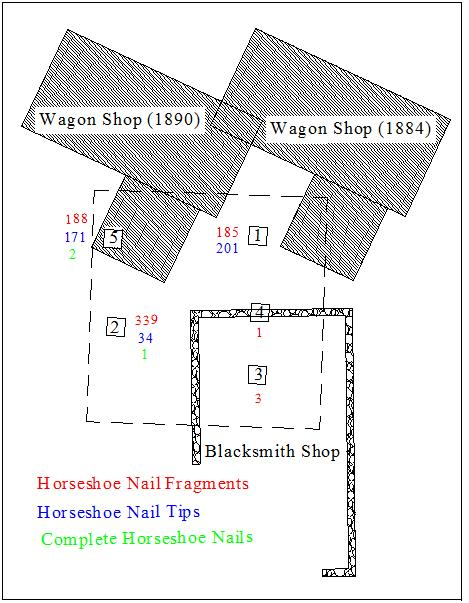The five units uncovered features and artifact deposits which allowed us a preliminary understanding of the blacksmith shop site, including identifying specific activity areas. The location of the brick forge was identified by its proximity to the wall (which would allow for easy ventilation) and the presence of 17 kg of brick in Unit 4. These pieces were recovered only from the portion of the unit "inside" the foundation wall; in contrast, brick recovered from the entirety of Unit 2 measured only 11 kg. The absence of slag and the presence of charcoal in the brick deposit show that this was a wood burning forge. However, coal was definitely used as fuel over the years as the slag deposits found outside the shop clearly show. It is therefore likely that a second forge existed elsewhere in the shop. The historic photo supports this assessment, as it clearly shows a doorway in the western side of the building. This doorway may have been installed when the road was realigned and the wagon shop moved back from the side road which formerly ran through the park.
The location of the anvil was found nearby in Unit 3 based on a lens of oxidized metal fragments (scale). The forge and the anvil form are heart of any blacksmith shop. The remainder of the shop floor was relatively clean, which strongly suggests that the smiths who owned or rented the building were conscientious about maintaining a neat work space.
Slag and other debris was regularly swept up and dumped south of the building, which was the side away from the side road depicted in the historic maps and photo of the shop. The south and especially the southwest yard of the shop had deep midden deposits. These deposits varied in their relative artifact densities, and showed that the area directly to the south (Unit 2) served more as a refuse pile for cleaning episodes whereas the area around Unit 5 contained refuse that may have been directly deposited. For example, the pieces of wagon hardware were found in Unit 5, which was directly behind the wagon shop as it stood in 1884. Most pieces of flat stock used for wagon wheels were also recovered in Units 1 and 5 rather than Unit 2. Unit 5 may have been covered by the building when it was pulled back from the road a few years later. Indeed, a post mold was found in this unit which may have been from a structural support.

Schematic plans of the site showing the stone foundation and the two mapped locations the wagon shop. The left side shows amounts of brick and slag recovered by weight from each unit, while the right side shows the relative amounts of different blacksmithing artifact classes recovered from each unit.
The distribution of horseshoe nails is even more evocative than that of wagon parts and coal slag. This is partly due to the central importance of shoeing to a blacksmith's bottom line, and conversely, the importance of the blacksmith's role as a farrier to historic communities. A regular job of a nineteenth century blacksmith was shoeing horses, and as the century came to a close, this job became more and more as the smith's mainstay. This activity leaves a clear archaeological signature which was observed at this site. To shoe a horse, the blacksmith would drive a nail through the horseshoe and through the hoof. The nail would be driven in at such an angle so that the tip of the nail would exit the side of the hoof. The blacksmith would then clip off the tip of the nail and hammer down the clipped end so it would grip the hoof. To remove a horseshoe, the blacksmith would clip off those hammered down ends, pull the nails out, and pull the shoe free. A nail incorrectly driven into a hoof was pulled and discarded; horseshoe nails were not reused. Horseshoe nails would often be left where they fell, as the shoeing was usually conducted outside the shop. A concentration of the clipped nail tips indicates the location of a shoeing station, as these small bits would be of little concern to smiths tidying their yards. Large concentrations of larger horseshoe nail fragments also can indicate a shoeing area, but they are more likely to be swept up. The presence of hundreds of nails would be an eyesore to even the messiest of smiths, though cleanliness was increasingly promoted in the late 1800s (Richardson 1889).
A spatial analysis of horseshoe nails shows that there were distinct clusters of nails and tips. Unit 1 and Unit 5 had high numbers of both nail fragments and nail tips, with almost equal quantities of each. In contrast, while Unit 2 contained the most nail fragments it contained very few tips. In fact, the fragments outnumbered the tips 10:1, whereas the other two yard units had a near 1:1 ratio of fragments to tips. The high counts of horseshoe nail tips in Units 1 and 5 shows that the bulk of shoeing took place west of the smith shop. The large amount of horseshoe nail fragments in Unit 2 indicates that this area was preferred for disposing the larger nail fragments. The disparity between larger fragments and small tips is so great here, that it suggests sweeping was not the preferred way to collect large nail fragments for disposal. If so, the small tips would have been swept up with the large fragments. Instead, it's likely that the smiths would drop the nails into a container as they were pulled from the hoof, whereas the tips would just fall from the clippers onto the ground and were ignored.
Just as the position of the wagon shop shifted between 1884 and 1890, it seems that the shoeing location changed as well. When the wagon shop was located in its 1884 position adjacent to the side road, shoeing could have taken place in the open area at the rear of the wagon shop. When the structure was moved to its 1890 position, shoeing activities shifted to the open area in front of the wagon shop.

Blacksmiths were an integral part of 19th century American life. Work on this site and others at PAF suggest that these types of sites may be very well preserved, as fill was used to bury the unsightly (and toxic) slag and metal debris after the shops were closed around the turn of the 20th century. A blanket of fill and its incorporation into the park preserved the site's spatial integrity and allowed us to see specific activities that were conducted at this important community business. The five units excavated for the site examination represented about 3.5% of the site within the project limits, and an even smaller percentage of the site as a whole, so much more remains to be done and learned. In the meantime, the information gained from this site has been presented at professional archaeological meetings (e.g., Zlotucha Kozub and Seib 2007) and was central to a greater analysis of blacksmith shops in scholarly publication (Seib 2011).